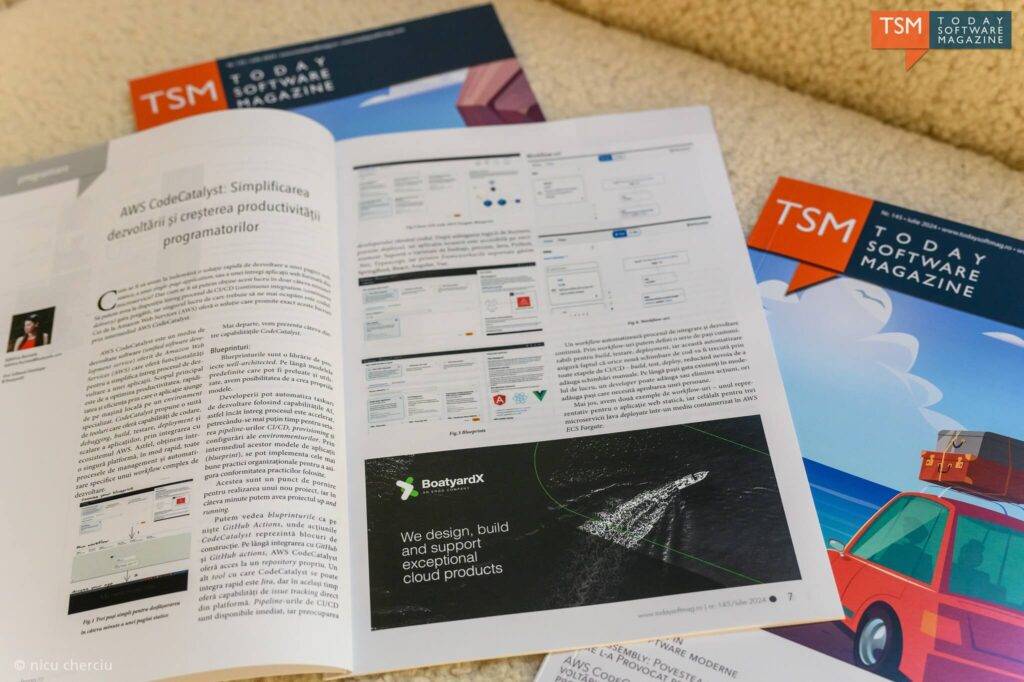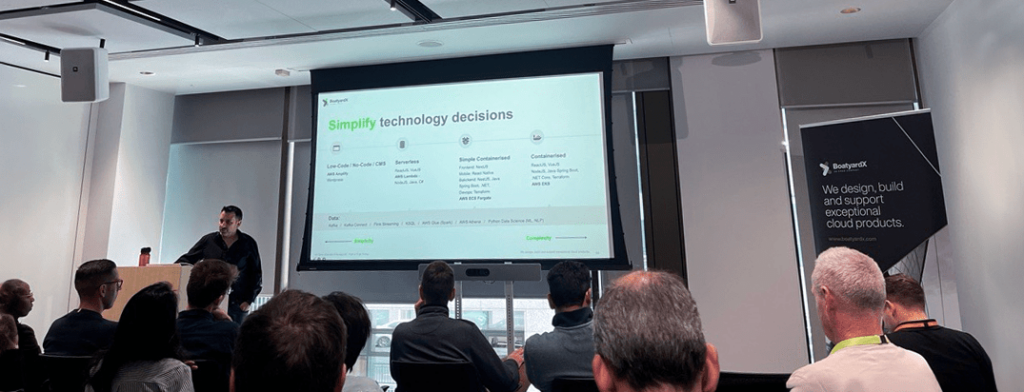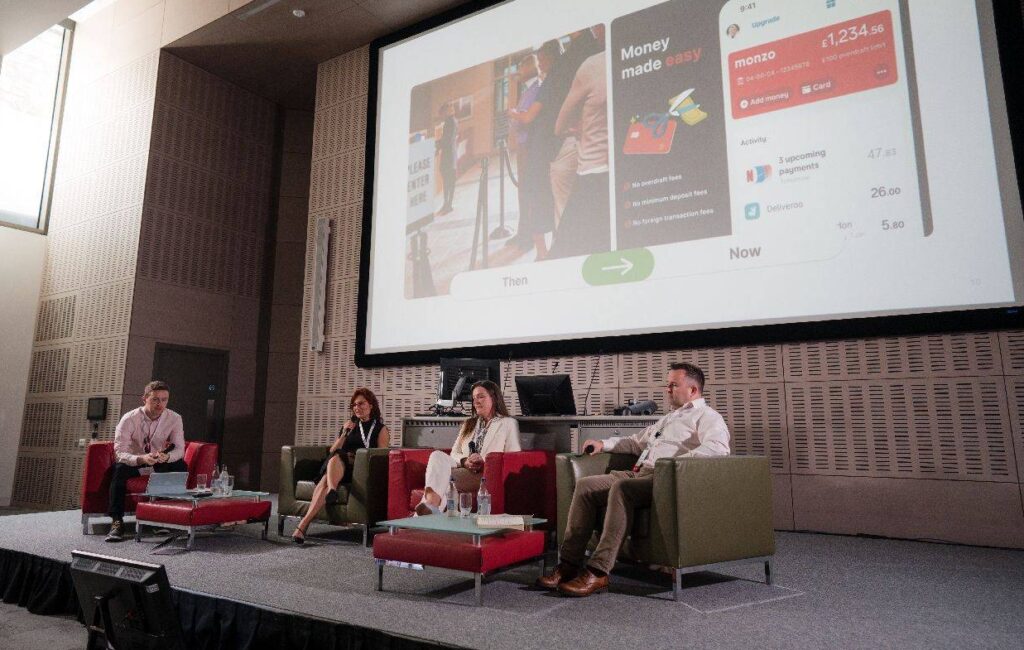- Diana Gabor, UX/UI Designer at BoatyardX
AI is reshaping how we work, shop, learn, and solve problems. Artificial intelligence is creating experiences that seemed impossible just years ago: from personalised recommendations that feel like mind-reading to fraud detectors that spot suspicious transactions in milliseconds.
But what separates AI that transforms businesses from AI that gathers digital dust is the human element. The most successful AI implementations don’t just showcase impressive technology, they solve real problems for real people in ways that feel natural and intuitive.
When AI is designed with users at the centre, it becomes invisible in the best possible way. It anticipates needs, removes friction, and enhances human capability rather than replacing it. This human-centred approach isn’t just about better user experience, it’s what determines whether your AI investment delivers measurable business value or becomes an expensive experiment.
Determining when AI makes sense
Every successful AI implementation starts with asking the right questions. Rather than jumping into development because AI is everywhere, smart companies evaluate whether artificial intelligence truly aligns with their goals and user needs.
| Strategic Alignment | Will this AI initiative directly support your business goals and deliver measurable impact? The most successful implementations tie directly to revenue, cost reduction, or competitive advantage. |
| Genuine User Value | Does it address a real pain point or meaningfully improve the user experience? AI that feels like a gimmick quickly becomes abandoned technology. |
| Competitive Differentiation | Can AI give your product capabilities that genuinely stand out in the market? Consider whether the competitive advantage justifies the investment. |
| Market Readiness | Are your industry and user base prepared for AI adoption? Timing can make or break even well-executed implementations. |
Findings from recent research confirm that most AI failures stem not from technological limitations, but from misalignment with business objectives and user needs. A thorough assessment prevents costly missteps.
The four pathways to AI value
Once desirability is confirmed, the next step is deciding the scale and ambition of your initiative. Choosing the right direction early helps set realistic expectations, budgets, and timelines.
⚡️ Efficiency-focused AI
Improves what you already have by streamlining processes, reducing errors, and increasing speed. Examples include predictive models that flag potential payment delays, or chatbots that handle first-line customer support. These projects tend to offer quick returns and carry relatively low delivery risk.
🧑💻 Experience-focused AI
Makes user interactions smarter, smoother, and more personalised. It adapts to individual preferences, anticipates needs, and removes friction from the user journey. Examples include recommendation systems that suggest the most relevant products and or adaptive interfaces that change based on behaviour patterns.
⚙️ System-level AI
Integrates intelligence into the core of your operational processes or platforms. Examples include AI that automatically assigns and prioritises support tickets, demand forecasting tools for inventory management, or intelligent scheduling assistants for project teams. These require deeper integration and change management but can significantly improve efficiency and scalability.
🆕 Transformative AI
Creates entirely new, AI-native products or services. This might be a recruitment platform that matches candidates to roles based on skills and cultural fit or a legal document assistant that drafts contracts using natural language processing. These projects carry higher complexity but can open new markets and deliver significant competitive advantage.
AI in action across different sectors
Understanding how AI creates value in different sectors provides concrete inspiration for your own product development. Here are some examples, as shown in a published review of AI applications across industries:
| Sector | Applications | Examples |
|---|---|---|
| Healthcare | Medical imaging, patient monitoring, early disease detection, hospital operations | IBM Watson Health, Google DeepMind, PathAI, Tempus |
| Education | Adaptive learning, automated grading, chatbots, predictive analytics, virtual simulations, emotion recognition | Pearson AI, Carnegie Learning |
| Finance & banking | Fraud detection, credit scoring, personalised advice, document automation | ZestFinance, Feedzai, Personetics, Darktrace |
| Telecommunications | AI-powered support, chatbots, network optimization, fraud prevention, translation | Vodafone, AT&T, Pindrop, Ciena Blue Planet |
| Retail | Personalization, inventory optimization, demand forecasting, sentiment analysis | Amazon, Walmart, Alibaba |
| Creative industries | AI-assisted music, generative art, creative writing | Amper Music, OpenAI Jukebox |
| Social impact & environment | Climate modelling, biodiversity monitoring, disaster response | WWF, Microsoft AI for Earth |
The UX-led process for AI success
For AI to deliver lasting impact, it needs to be grounded in a set of human-centred design principles. These principles guide every decision, from concept to launch, ensuring that AI not only works technically but also works for the people who use it.
Trustworthy – Users need transparent reasoning, consistent outputs, and clear boundaries. Explainability directly influences user trust, especially in high-stakes contexts.
Usable – AI should integrate seamlessly into existing workflows without adding friction. The best AI feels almost invisible — it makes tasks easier rather than introducing new complexities.
Accessible – Design must be inclusive for people with different abilities, languages, and contexts. AI that only works for a subset of users ultimately fails for everyone.
Ethically responsible – Systems must minimise bias, protect privacy, and consider broader societal impact. These aren’t add-ons; they must be part of the foundation from the start.
Human-centred AI doesn’t emerge by chance, it’s the result of a deliberate discovery process that blends UX methodology with AI expertise from the very beginning.
Step 1: Map the problem space
This isn’t about looking for places to insert AI for the sake of it. It’s about identifying problems where AI could be the best solution. Look for repetitive tasks, decision bottlenecks, or workflows that could be streamlined through intelligent automation. Capture the questions users need answered to trust and effectively use the AI system.
Step 2: Define and prioritise experience goals
This isn’t about looking for places to insert AI for the sake of it. It’s about identifying problems where AI could be the best solution. Look for repetitive tasks, decision bottlenecks, or workflows that could be streamlined through intelligent automation. Capture the questions users need answered to trust and effectively use the AI system.
Step 3: Prototype and validate in context
Create realistic prototypes that demonstrate AI functionality in real-world scenarios. Gather feedback early to refine design choices before major development investment.
Step 4: Iterate and scale
Refine the AI based on real user feedback, then deploy with continuous monitoring to ensure it remains accurate, relevant, and aligned with user expectations.
Making AI work in the real world
AI’s extraordinary potential to transform products and services is undeniable, but the key to realising that potential lies in ensuring you’re building the right AI for the right problem, with people at the centre from the very start. A human-centred, UX-led approach doesn’t just help avoid costly mistakes. It maximizes return on investment by creating systems that users trust, adopt, and find genuinely valuable. The most successful AI implementations feel less like impressive technology demonstrations and more like natural extensions of human capability.
Ready to explore AI for your product? Our team specializes in UX-led AI discovery, helping organisations identify high-impact opportunities and design human-centred solutions that deliver measurable value. From initial desirability assessment to successful deployment, we guide you through every step of the journey.
Revenue models alone don’t determine UX quality. Instead, thoughtful design choices, strategic investments, and a user-centred approach are what truly make the difference. Whether your platform is free, paid, or somewhere in between, success hinges on balancing performance, usability, and accessibility. These aren’t just checkboxes; they’re essential elements that directly impact user satisfaction, loyalty, and ultimately, your business’s bottom line.
Whether you’re building a news platform, or any digital product, balancing performance, usability, and accessibility is key. At BoatyardX, we simplify these complexities to create platforms that exceed user expectations.
Read more tech topics
Modernise smarter, scale faster. BoatyardX helps you cut costs and unlock agility by transforming legacy apps through our DiscoverX process and the AWS 7Rs framework.
AI is reshaping how we work, shop, learn, and solve problems, it's creating experiences that seemed impossible just years ago. But what separates AI that transforms businesses from AI that gathers digital dust?
Cloud migration promises scalability, innovation, and long-term cost efficiency. Beneath the surface, however, many organisations encounter unexpected expenses that can derail timelines and budgets.
In recent years, software architectures have evolved rapidly, reflecting the changing needs of software developers and the business environment.
There’s a common belief in the digital world: paying for something guarantees a better experience. But is this always true?
How convenient would it be to have a quick solution at hand for developing a static web page, a proof-of concept application, a single-page application, or even a complete web app built with microservices?
Building a cloud-based product can be daunting for startups, especially when faced with a plethora of choices, trade-offs, and challenges.
Proud of your product but sense it hasn’t quite hit its stride? UX audits are an essential tool to ensure it hits its full potential.
At Adminovate 2024, Karolina Coates, Head of Design at BoatyardX, joined industry leaders to discuss the evolving landscape of user experience (UX) and fintech innovation.
The BoatyardX DiscoverX workshop is a collaborative, interactive experience where clients have the opportunity to explore product and technology concepts.
In today's fast-paced digital landscape, businesses are continually seeking innovative solutions to manage their infrastructure efficiently – and for good reason.
Within the sphere of modern applications, prioritising user experience has become paramount.
Whether you are a startup or a large corporation, it's likely you will face many of the same challenges in building the first version of a new product or application. We explore some of the critical success factors and lessons learned from supporting a broad range of clients in bringing new products to life.
We live in the times when seamless user experiences (UI/UX) are the cornerstone of digital success, businesses are strategically leveraging the nearshore advantage to bolster their design teams.
Before solution and implementation are merged into the upstream branch, a code review is a crucial stage in the software development cycle to obtain a second viewpoint.
Computer vision has become a significant influence in the remaking of numerous sectors in a time when technological innovation is the driving force.
In today's rapidly evolving digital landscape, the success of a product or service hinges on the user experience (UX) it delivers.
With over four years of experience as a .NET developer under his belt, Petru felt it was time to explore the growing demand for DevOps expertise, specifically in technologies.
WebRTC (Web Real-Time Communication) is an open-source transformative technology that revolutionizes real-time audio, video, and data sharing within web browsers.
What do startup founders and enterprise technology leaders have in common? Nightmare stories about unintended consequences of technology decisions.
Cognitive biases can have a significant impact on the quality and effectiveness of software being developed. How can software developers mitigate this impact?
At a recent Microsoft event speakers and attendees struggled to best describe the significance of AI and its potential impact on enterprise.
More organisations are starting to realise that the cloud is a great enabler for innovation, not just a more efficient way of running IT applications and services.
Skill gaps, high employee turnover and fierce competition for limited talent have only added to the pressure that businesses are facing from inflation. Though it may seem counter intuitive, it’s actually a good time to modernise or even replace applications, because they could be compounding your skills challenges.
Meta has called 2023 ‘a year of efficiency’ and they are far from alone in the corporate world. Many businesses are knuckling down, shedding staff and focussing on the old adage of ‘doing more with less’. Belt tightening is a business initiative again, like the bad old days of 2008.
Factors to consider when deciding whether or not to automate your QA.
At close to 4 years old BoatyardX has, for most of its short life, been a remote-first organisation.
How design helps you validate your product ideas within our Discovery Framework.
Have you ever wondered what it takes to have that genius spark that leads to groundbreaking, brilliant ideas?
This article briefly highlights the challenges faced by many software companies, and elements of the solutions we’ve helped map out with them.
This article briefly highlights the challenges faced by many software companies, and elements of the solutions we’ve helped map out with them.
De-risk your product build by answering fundamental product and technology questions up front
Often entrepreneurs skip brand development because of budget limitations or lack of available skillset. A solid brand strategy is, however, the foundation of a successful venture which stands out from the crowd.
An active player on the IT scene, BoatyardX was featured by Today Software Magazine (RO) in tech related topics as a subject matter expert.
When technology isn’t your core business it makes sense to go to an external partner such as BoatyardX. Discover how this approach works for Toronto-based Global Solutions Team.
We were recently interviewed by a new Software Insider website using a Reporter BOT, and it didn't go great! Sometimes #articialintelligence isn't as smart as we'd expect! See what you think.
Irish technology company BoatyardX delivers a compelling case for moving to the cloud to ensure the viability of your operations for the future.
As a growing start up, it’s important not to lose sight of the security and controls required on the IT systems that underpin the business. See how a recent Pen Test has resulted in significant cost savings at BoatyardX.
Pushing a new product live and then helping to demonstrate to early beta customers is a fantastic experience for a software development team.
BoatyardX’s approach to the cloud uses scalable, flexible Kubernetes technology. For businesses undergoing digital transforming, it is the wisest strategy.
Covid-19 represents both a driver and an opportunity for businesses to use digital innovation and build new products and applications more rapidly.








































